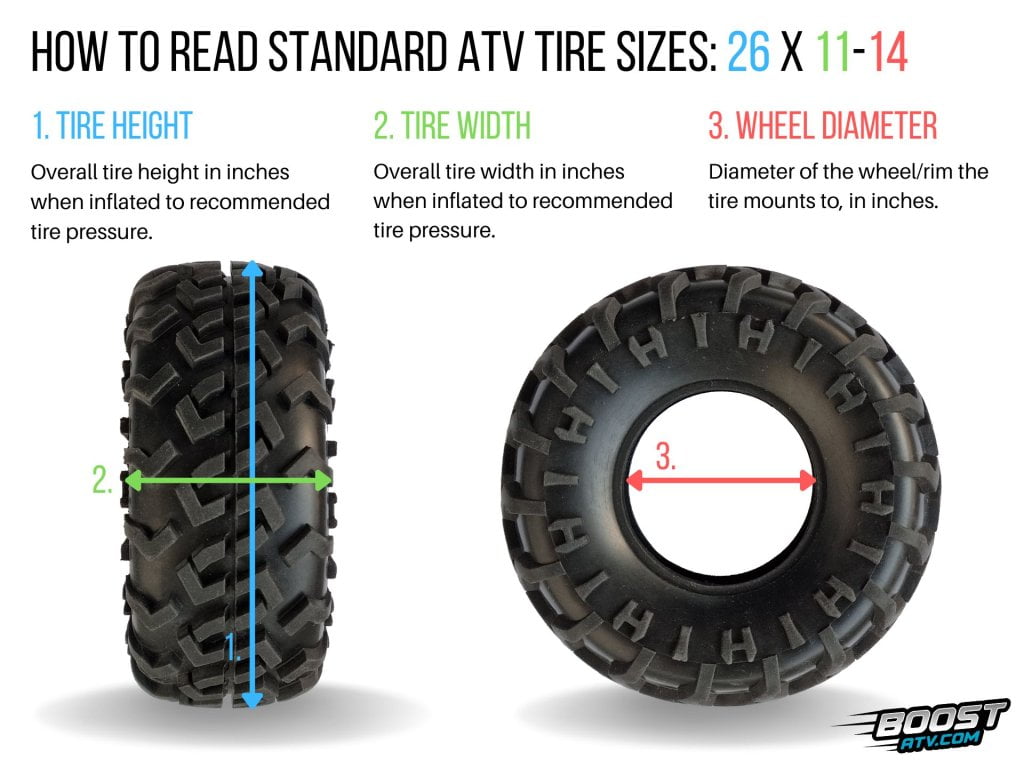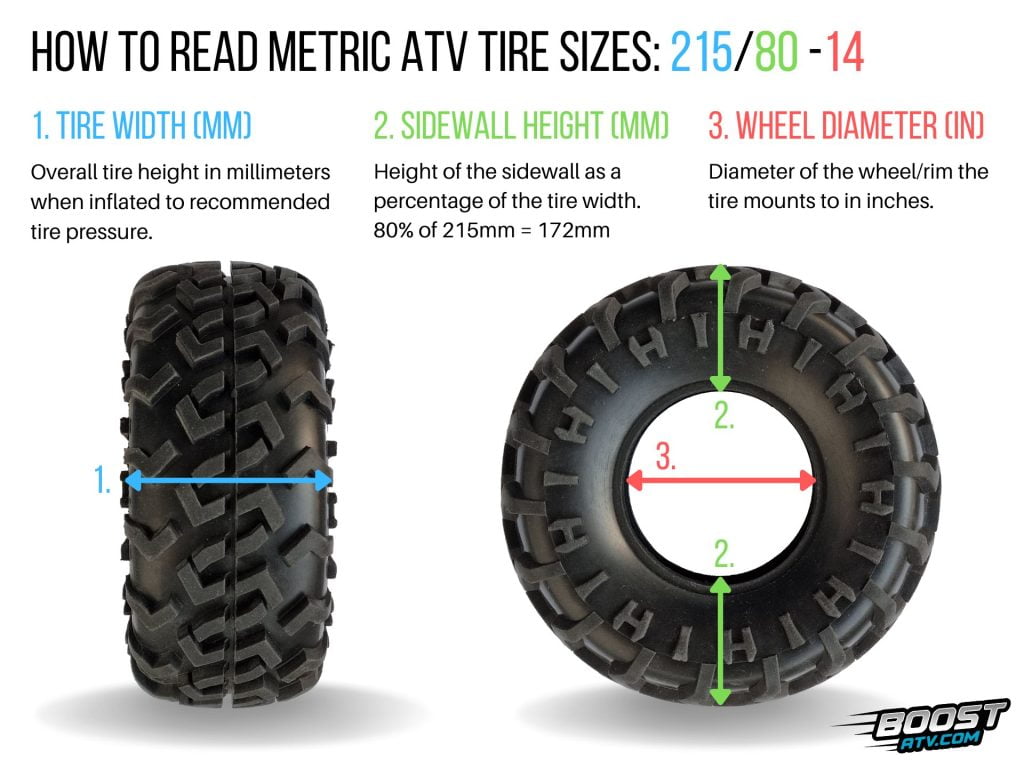When replacing the tires on your ATV, you must choose from a wide range of tire sizes. In this post, you’ll find information about the most common ATV tire sizes, a few real-life examples, how to read ATV tire sizes, and how to be confident you choose the right size for your ATV.
How To Read ATV Tire Sizes
ATV tire sizes are displayed on the tire’s sidewall, and you’ll generally find them in either of two sizing formats:
- Imperial (measured in inches): Examples include 27X10R12 or 27X10-12.
- Metric (measured in millimeters and inches): Examples include 215/80R14 or 215/80-14.
Out of the two, the imperial format in inches is most common in ATV tires. Metric sizing is more common in car tires, but now and then, you’ll stumble across an ATV tire with metric sizing.
ATV tire measurements should always be taken when the tire is inflated to its recommended pressure.
The simplest way to identify a metric tire size is by looking for a slash “/” between the first and second numbers rather than a multiplication sign “x.”
Also, the numbers on a metric tire are typically larger. Since 100 millimeters is equivalent to 25.4 inches, the values on a metric tire will be higher than those on a standard (imperial) tire.
- To convert from mm to inches, you divide by 25.4.
- To Convert from inches to mm, you multiply by 25.4
How to Read Standard Imperial ATV Tire Sizes
The three numbers in the standard imperial tire sizing format represent three critical tire dimensions.
- First number: The overall tire height in inches when inflated.
- Second number: The overall tire width in inches when inflated.
- Third number: The wheel or rim diameter in inches.
For example, a 26X11-14 size tire is 26 inches high and 11 inches wide and will mount to a wheel or rim that is 14 inches in diameter.
A Letter “R” between the second and third numbers indicates a radial construction tire, while a hyphen “-” indicates a bias ply tire.

How to Read Metric ATV Tire Sizes
The metric tire size format is not as self-explanatory as the standard imperial format. To make matters worse, it doesn’t only use millimeters but also inches, percentages, and letters.
Luckily, you are much less likely to come across a metric-sized ATV tire. If you do, here is how to know what size it is.
- First number: The overall tire width in millimeters when inflated.
- Second number: The sidewall height as a percentage of the tire width.
- Third number: The wheel or rim diameter in inches.
For example, a 215/80-14 size tire is 215mm wide, has a sidewall height of 172mm (80% of 215mm) and will mount to a wheel or rim that is 14 inches in diameter.
A Letter “R” between the second and third numbers indicates a radial construction tire, while a hyphen “-” indicates a bias ply tire.

What Size Are ATV Tires?
An average ATV tire is 25 to 27 inches tall and 7 to 10 inches wide, with a wheel diameter of 10 to 12 inches. Sport quad tires are usually slightly smaller than average, while mud tires are generally larger than standard tires.
In everyday speech, ATV tires are often referred to only by the tire’s outer diameter. Typical tire sizes can be categorized by ATV type :
- Recreation and utility: 24 to 28 inches.
- Sport and racing: 20 to 25 inches
- Mudding and rock crawling: 27 to 32 inches or more
Note that the front tires are usually one or two inches narrower than the rear tires.
Related: Why Do ATVs Have Smaller Front Tires? 9 Good Reasons
ATV Brand and Model | Front Tire Size | Rear Tire Size |
Polaris Sportsman 450 | 25X8-12 | 25X10-12 |
Polaris Sportsman 1000 | 27X9-14 | 27X11-14 |
Can-Am Outlander 450 / 570 (base model) | 25X9-12 | 25X11-12 |
Can-Am Renegade 1000 | 25X8-12 | 25X11-12 |
Can-Am Outlander 1000 | 26X8-12 | 26X10-12 |
Honda Fourtrax Foreman 520 | 25X8-12 | 25X10-12 |
Yamaha Grizzly 700 | 27X10-14 | 27X10-14 |
What Size Are Youth ATV Tires?
Youth ATVs are smaller in size and power than adult models, so their tires must also be smaller.
A typical youth-sized ATV tire is between 18 to 21 inches tall and 7 to 10 inches wide, with a wheel diameter of 8 to 10 inches.
ATV Brand and Model | Front Tire Size | Rear Tire Size |
Can-Am Renegade 110 | 19X7-8 | 19X9,5-8 |
Honda TRX 90 | 20X7-8 | 19X8-8 |
Honda TRX 250 | 22X7-10 | 22X10-9 |
Yamaha YFM 90 | 18X7-8 | 18X9-8 |
Why Do ATV Tire Sizes Vary So Much?
At a glance, most ATV tires look the same. But when you go to a tire shop in real life or online, you soon realize there are almost endless sizes to choose from. But why does it have to be this way? Why don’t all ATVs use the same size tire?
The wide range of available ATV tire sizes reflects the versatility ATVs are well-known for and the wide range of conditions they go in.
Different riding applications and riding conditions require different tire sizes for optimal performance.
For instance, you need a larger tire when riding in soft and muddy conditions so you won’t sink in as much.
However, bigger tires are generally much heavier than smaller ones, negatively impacting acceleration and handling. That is why race quads typically use smaller tires.
ATV race tracks often feature medium to firm surfaces, such as dirt or gravel, which don’t necessitate large tires to avoid getting stuck.
To win a race, it’s more important to use a lightweight tire that spins quickly to convert as much engine power as possible to acceleration and speed.
And finally, for most ATV riders, including those that use the vehicle for utility tasks, trail riding, or hunting, it’s all about finding a happy medium. That is why most ATV tires are from 25 to 27 inches tall.
Related: Will Bigger Tires Make an ATV Faster? (Or Slower?)
How to Know What Size ATV Tire You Need
You cannot choose any size tire and expect good results. Your best bet would be to choose the same size as printed on the sidewall of your old ones.
Cross-reference the numbers against those specified in the user manual to ensure nobody has previously changed to a different size tire.
You can measure and compare to ensure your chosen tire fits the wheel/rim.
- The third number on the tire sidewall should always be identical to the diameter of your wheel.
- The tire width is typically one or two inches wider than the wheel. The front wheel is usually an inch or two narrower than the rear.
Can You Install Bigger Tires on Your ATV?
Many people wonder whether they can install bigger tires on their ATVs. There are several reasons why people want to upgrade to beefier tires:
- Better flotation in wet and soft conditions.
- More ground clearance to better steer clear of obstacles.
- A more aggressive tread pattern for better grip in soft and slippery conditions.
Generally, you can install one to two inches larger diameter tires without modifying the ATV. Larger tires require various modifications to prevent tire rubbing, gear ratio issues, loss of torque, and premature belt wear.
Please refer to this post to learn more about things to consider when installing bigger tires.
